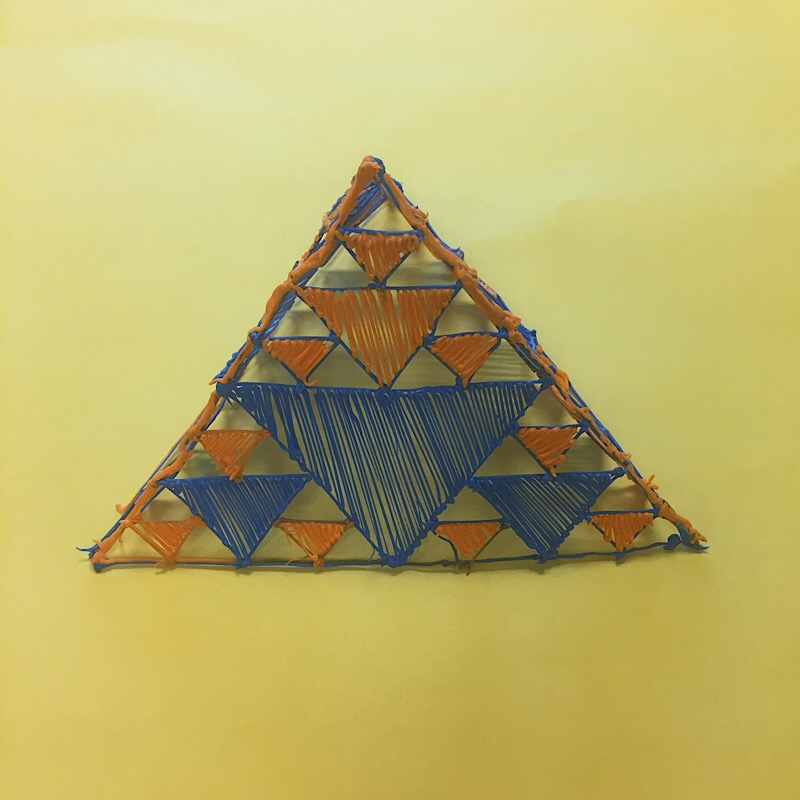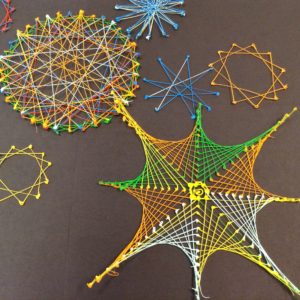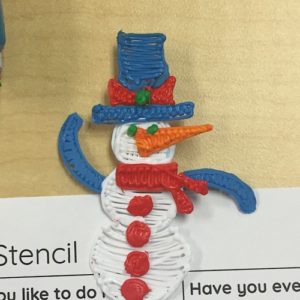MATH: Fractal Fractions
In this FRAC-tivity, students will work in pairs to explore fractions and Sierpinski's Triangle. Working in pairs, students will 3Doodle a series of triangles that represent the progressive stages of a Sierpinski's Triangle and then record data as fractions. Students will then interpret observable patterns based on recorded data.

KnowledgeStudents havelearned and practiced using fractions to identify a part of the whole.
had practice using the 3Doodler.
learned and practiced using fractions to identify a part of the whole.
had practice using the 3Doodler.
ObjectivesStudents willuse a 3Doodler to draw the first 4 stages of the Sierpinski Triangle.
record each shaded portion of the Triangle as a fraction.
observe and interpret recorded data as a pattern.
make predictions on successive stages of the Sierpinski Triangle based on interpretation of data.
use a 3Doodler to draw the first 4 stages of the Sierpinski Triangle.
record each shaded portion of the Triangle as a fraction.
observe and interpret recorded data as a pattern.
make predictions on successive stages of the Sierpinski Triangle based on interpretation of data.
MaterialsStudents will need3Doodler (1 per pair)
white construction paper (1 per pair)
pencil (2 per pair)
3Doodler (1 per pair)
white construction paper (1 per pair)
pencil (2 per pair)
Lesson PlanInstructions
Step 1Define a fractal as a repeating "self-similar" pattern. Explain that they are often found in nature, as seen in the repeated and successive branching of a tree. Visit this Fractal Geometry Page to learn more about fractals in nature.
Step 2Project your tablet or computer screen for students to view the Sierpinski Triangle Worksheet. Share that the Sierpinski Triangle is named after the Polish mathematician Waclaw Sierpinski. Explain that the Sierpinski Triangle repeats a series of triangles within triangles.
Step 3Demonstrate how to use the triangles on the worksheet as stencils. Students will be constructing a Sierpinski Triangle, step-by-step, beginning with Triangle 1. Note how to record data for each triangle as fractions in the related table on the worksheet
Step 4Hand out Sierpinski Triangle Worksheets, pencils and 3Doodlers. Instruct students to trace stencils of Triangles 1-3 with the 3Doodlers and record the related data in the table on the sheet.
Step 5Circle to assist and assess as students work on completing Triangles 1-3.
Step 6Instruct students to stop before beginning Triangle 4. Note that they will be adding to this triangle to continue some sort of pattern. Prompt students to review and interpret data recorded in the table on the Sierpinski Triangle Worksheet.
Step 7Check students' work before allowing them to use the 3Doodler on Triangle 4.
Step 8Have the students complete the table, predicting the results for triangles 5-8 with a pencil.
Define a fractal as a repeating "self-similar" pattern. Explain that they are often found in nature, as seen in the repeated and successive branching of a tree. Visit this Fractal Geometry Page to learn more about fractals in nature.
Project your tablet or computer screen for students to view the Sierpinski Triangle Worksheet. Share that the Sierpinski Triangle is named after the Polish mathematician Waclaw Sierpinski. Explain that the Sierpinski Triangle repeats a series of triangles within triangles.
Demonstrate how to use the triangles on the worksheet as stencils. Students will be constructing a Sierpinski Triangle, step-by-step, beginning with Triangle 1. Note how to record data for each triangle as fractions in the related table on the worksheet
Hand out Sierpinski Triangle Worksheets, pencils and 3Doodlers. Instruct students to trace stencils of Triangles 1-3 with the 3Doodlers and record the related data in the table on the sheet.
Circle to assist and assess as students work on completing Triangles 1-3.
Instruct students to stop before beginning Triangle 4. Note that they will be adding to this triangle to continue some sort of pattern. Prompt students to review and interpret data recorded in the table on the Sierpinski Triangle Worksheet.
Check students' work before allowing them to use the 3Doodler on Triangle 4.
Have the students complete the table, predicting the results for triangles 5-8 with a pencil.
Wrap Up
Assessment
Possible Extensions
Vocabulary
acute angle - An angle that measures less than ninety degrees but more than zero degrees.
angle - the (rotational) space between two intersecting lines.
collaboration - to work jointly with others or together especially in an intellectual endeavor.
drawing - the art or technique of representing an object or outlining a figure, plan, or sketch by means of lines.
fractal - any of various extremely irregular curves or shapes for which any suitably chosen part is similar in shape to a given larger or smaller part when magnified or reduced to the same size.
line - an infinite extent which is one-dimensional and straight.
measurement - the act or process of measuring; a figure, extent, or amount obtained by measuring.
nature - the physical world and everything in it (such as plants, animals, mountains, oceans, stars, etc.) that is not made by people.
obtuse angles - Angles larger than 90 degrees.
pattern - an artistic, musical, literary, or mechanical design or form.
perpendicular - being at right angles to a given line or plane.
problem-solving - the process or act of finding a solution to a problem.
ratios - the relationship in quantity, amount, or size between two or more things.
repeat - renewed or recurring again and again.
symmetry - the correspondence in size, form, and arrangement of parts on opposite sides of a plane, line, or point; regularity of form or arrangement in terms of like, reciprocal, or corresponding parts.
tree - a woody perennial plant having a single usually elongate main stem generally with few or no branches on its lower part.
Educational Standards
Generate and analyze a pattern.
Students will construct a stencil and 3Doodle a Sierpinski Triangle.
Represent and interpret data.
Students will record their data as fractions and make interpretations about the Sierpinski Triangle.
Draw points, lines, line segments, rays, angles (right, acute, obtuse), and perpendicular and parallel lines. Identify these in two-dimensional figures.
Students will draw a stencil of a Sierpinski Triangle using lines and angles.
Recognize a line of symmetry for a two-dimensional figure as a line across the figure, such that the figure can be folded along the line into matching parts. Identify line-symmetric figures and draw lines of symmetry.
Students will recognize symmetry within a Sierpinski Triangle.
Decompose (break down) a larger problem into smaller sub-problems with teacher guidance or independently.
Students will break down the process of analyzing a Sierpinski Triangle through a multistep process of designing a stencil for one, then 3Doodling it, and recording and interpreting data.
Use technology to seek feedback that informs and improves their practice and to demonstrate their learning in a variety of ways.
Students will use the 3Doodler to create a Sierpinski Triangle.
Create original works or responsibly repurpose or remix digital resources into new creations.
Students will use a 3Doodler to create a Sierpinski Triangle.
Use collaborative technologies to work with others, including peers, experts or community members, to examine issues and problems from multiple viewpoints.
Students will seek feedback from partner to interpret data, i.e., fractions from Sierpinski Triangle.





